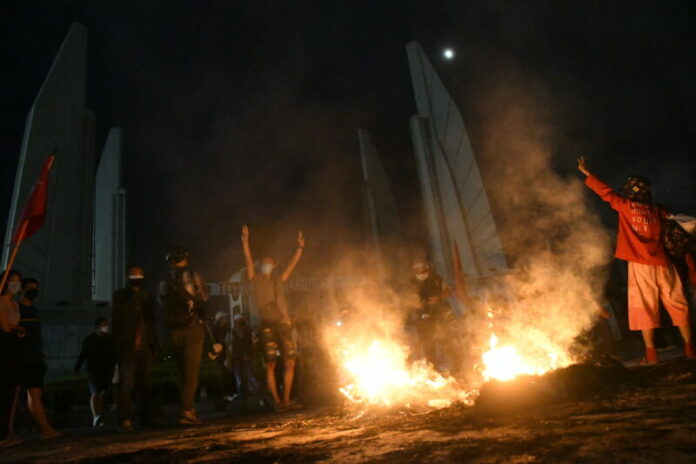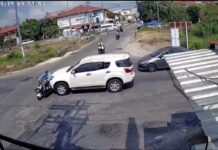
On Wednesday evening, anti-government’s Thalu Fah group reached out not to the government but to angry young protesters at another site in Bangkok not to resort to violence.
“Violence is not the answer,” said one through a loudspeaker with the speech carried out through Facebook Live. Another warned that the military could use the near-nightly violent confrontation with anti-riot police around Sam Liam Din Daeng Intersection as a pretext for a military coup that would set Thailand back even further.
Many teenage protesters who descend to Sam Liam Din Daeng Intersection over the past week on a nightly basis, to clash with fully-armed riot police in an attempt to get through the container barriers set up by police to ‘visit’ the residence of Prime Minister Gen Prayut Chan-O-cha in order to pressure Prayut to resign have made up their mind, however.
After spending a few evenings there, these are my observations about the new teenage political protesters that have turned Din Daeng Intersection into their battle field against riot police over the past two weeks.
First, many of the hundreds of these protesters, aged from 14 to early twenties are mostly from the working class. A good number of them have small motorcycles making them very mobile when confronting riot police. Their families are among the hardest hit and most affected by the COVID-19 mismanagement of the economy and the overwhelmed public health system.
They are not middle class intellectuals like the earlier wave of monarchy-reform protesters and protest leaders from top universities like Thammasat, Chulalongkorn or Mahidol. Many are still in high school or studying at vocational colleges.
Second, they do not take orders from any leader, young or old. Former redshirt co-leader Nattawut Saigua tried and failed to convince them to go home and not confront police by visiting the clash site on Sunday evening. Thalu Fah group also failed after pleading on Wednesday. I spoke with some of these young protesters, and one, a 16-year-old, said he takes orders from nobody. They don’t take orders from middle-class protest leaders and are more than willing to continue the militant protest at the same site long after other groups have called it a day.
Third, they have their own way of expressing themselves. It is through the willingness to violently confront riot police with rocks, slingshots, water and glass bottles, wooden and metal sticks, fireworks and homemade explosives and attack police symbols that they manifest themselves. Riot police largely fired teargas, rubber bullets and used water cannons against the protesters although three young protesters have been injured by live ammunition from unidentified shooters with one, age 15 and shot on Monday night, currently still in a coma and dependent on a ventilator.
Another, Nat Thanakitamnuay, though not from the group, considerably older, rich and privileged, and publicly professed non-violent struggle, lost his right eyesight after what he said was a teargas canister hit his right eye’s socket on Aug 13 in the area. On Friday night, 23 protesters were arrested and 16 of them were under the age of 18, according to Thai Lawyers for Human Rights. On that night, a police officer fired rubber bullets at close range while some young protesters hurled Molotov cocktails.
For these young protesters, hitting back at the police is a fair game and the only game. So is setting police traffic booths on fire as they attack the symbols of police repression. No lootings of shops have been reported so far, however and I do not expect any since Bangkok is not LA. These people want to express anger at the regime and system that’s keeping them close to the bottom of society. The middle-class’ theories about non-violence are irrelevant to them and not attractive. What’s attractive is for them to converge together in a state of ‘communitas’, anthropologically speaking, where they feel empowered and capable of expressing their collective anger at the system that offers them bleak economic and political prospects and future as they see little hope or light at the end of the tunnel.
The irony of all these is that many riot police are also from the working class, particularly those enlisted from the Border Patrol Police units. These officers were primarily trained to deal with cross-border threats and criminals like drugs and human traffickers and to control ethnic minorities along the borders of Thailand. They were trained to be more like official paramilitary troops. They are not the type of ‘service-minded’ police infamous at Thonglor police station in the affluent parts of the capital or as tourist police. It’s thus almost inevitable that they see these young hardline protesters as enemies.
These rank and file police may be also from the working class but trained by the system to serve the oppressive state and the powerful as they battle against angry young protesters on the streets of Bangkok almost nightly now.










































